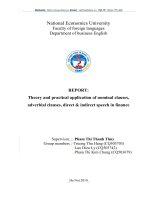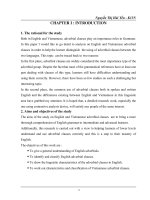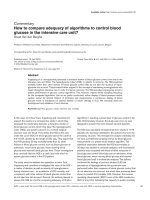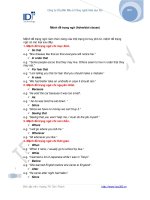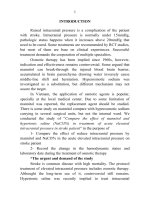Compare adverbial clause in EnglishVietnamese
Bạn đang xem bản rút gọn của tài liệu. Xem và tải ngay bản đầy đủ của tài liệu tại đây (553.42 KB, 66 trang )
English Adverbial Clauses and their Vietnamese Equivalents
VINH UNIVERSITY
FOREIGN LANGUAGES DEPARTMENT
=✍
✍=
Module
ENGLISH GRAMMAR
ADVERBIAL CLAUSES
ENGLISH ADVERBIAL CLAUSES AND THEIR VIETNAMESE EQUIVALENTS
Class : K62 – ENGLISH GRAMMAR
Group members:
1. Lê Thị Minh Hoài (Leader)
2. Phùng Thị Hồng Lan
3. Lê Thị Hằng
4. Vũ Công Đức
5. Mạnh Thị Huyền Trâm
6. Nguyễn Thị Nguyệt
LECTURER:NGUYEN THI KIM
ANH
PART A: INTRODUCTION
1. Reasons for choosing the study
The use of English is a topic as broad as the English language itself. So far, the
majority of usage is uncontrollable and poses no problem for native English
speakers, just because it is their native language. However, there are certain
problems for learners of English as a foreign language, especially English
structures. Because many of them often don't recognize these types of adverbial
clauses.
In linguistics, adverbs are considered to be one of the most interesting parts of
Most linguists would say that adverbs have become buzzwords in
investigate grammar, especially in Vietnamese (Nguyen & Nguyen, 2004).
Vietnamese plays an important role and is widely used not only in literature but
also
In everyday conversations, similarly, adverbs are the most diverse grammatical
structures in
English is considered an indispensable auxiliary part of a sentence.
focus disproportionate views on advertising in Vietnamese and Vietnamese
through
three aspects: form, function and location. Thought this article would help the
language
learners have certain knowledge of adverbs in the two language systems as well
as
avoid some errors when using them. In addition, some teaching suggestions are
discussed in
This article can give some ideas for teachers to design adverb-appropriate tasks.
❖ Example: I worked twelve hours a day and was completely exhausted.
They suggest that this sentence could be a time clause "I worked a twelve-hour
day and was completely exhausted" or "I was completely exhausted after working
for twelve hours" This sentence also can be a reason clause "Because I had
worked twelve hours a day, I felt exhausted".
Adverb clauses are a very important part of English grammar, but they are not
easy to use and often cause difficulties for learners. English adverb clauses have
been handled by many grammarians. But until recent years, there has been no
research work on English adverb clauses and their Vietnamese equivalents and
how to help learners overcome confusion.
2. Aims of the study
The above basis shows that the status of adverbial clauses in English needs to be
studied in more detail not only in terms of structure but also in usage. With this trend
in mind, this study aims to:
- Identify Adverbial correctly, use Adverbial in a reasonable sentence, avoid making
many mistakes and lacking logic in speaking and writing.
- Give descriptions and characteristics of English adverb clauses and their equivalent
interpretations in Vietnamese to illustrate the differences and similarities of adverb
clauses in the two languages.
- Give suggestions to teach about adverbial clauses for Vietnamese learners.
- Find out the difficulties and solutions for learning English in general and the use of
sentence structure for Adverbial in particular.
- Bringing conclusions to teaching and learning English in a new way, with the slogan:
" Language is a Corridor for Life "
* Research questions
Defined by its objective, this article attempts to find answers to the following
questions:
1. What is an adverb clause?
2. What are the characteristics and classification of adverbial clauses?
3. What are the differences and similarities between English adverb clauses and
equivalent clauses in Vietnamese and how do they serve to teach English
grammar to Vietnamese students?
4. What are the prediction errors that Vietnamese students may make when
learning English adverb clauses?
5. How to remove these errors?
6. Difficulties for English learners?
7. How should effective English learning and teaching methods be devised,
consistent with actual requirements?
3. Scope of the study
This thesis is about adverbial clauses, in particular, we focus on types of adverb
clauses, adverbial clauses in English and their equivalents in Vietnamese. In addition,
we will provide learners with how to correct errors using adverbial clauses.
More specifically, we will take specific texts and analyze them through fields,
information, magazines, English books and research topics in the curriculum.
4. Research Methodology
1.1.Method of Explanation
1.2.Analytical methods
1.3.Proof method
1.4.Comment Method
1.5.Compare and contrast methods.
1.6.Methods of investigation and survey
1.7.The method of data collection
1.8.Statistical methods.
1.9.Experimental method.
5. Design of the study:
There are three primary aspects to this subject, as well as references.
Part A: The Introduction explains why the study was done, what it was for, what
it was for, what it was for, what it was for, what it was for, what it was for, what
it was for, what it was for, what it was for, what it was for, what it was for, what
In addition, the thesis' arrangement is discussed.
Part B, "Investigation," is broken down into three chapters.
The first, "Theoretical preliminaries," provides an overview of English sentence,
clause, and adverbial clauses.
The second chapter, "Concrete situations of adverbial clauses in English and
their Vietnamese equivalents," compares and contrasts English and Vietnamese
adverbial clauses. The focus of the presentation is on the syntactical
characteristics, functional functions, and concrete examples of each type of
adverbial phrase in the sentence.
The study's applicability to the teaching of English adverbial clauses to
Vietnamese students are discussed in the last chapter.
Part C is a summary of the important points mentioned in the preceding
sections.
PART B:
INVESTIGATION
CHAPTER 1: THEORETICAL PRELIMINARIES
1.1. Sentence and general knowledge of adverbial in sentence
1.1.1. Definition of sentence
A sentence is simply described as "made up of words" in conventional
grammar, and it serves a syntactic purpose by indicating which words may be
paired with other words to construct sentences and in what order.
The internal structure of a phrase must be used to define it linguistically. A
phrase will be made up of a number of distinct pieces in a specified order, as
well as words or portions of words.
A sentence is made up of a group of words that are ordered in a specific
sequence and structure to communicate a thought, inquiry, or instruction.
Subject, Verb, Complement, Adjective, Complement, and Adverb are the six
essential parts that make up an English sentence. These six factors are regarded
as the six essential requirements for the formation of sentences.
An adverb clause is a clause that has the grammatical function of an
adverb (modifies another clause). Adverb clauses are often called subordinate
clauses (which are clauses that do not express a complete idea and cannot stand
alone.)
1.1.2. Parts of sentence
According to Randolph Quirk et al (1972), sentences contain two basic parts:
subject and predicate, with the subject being a word or phrase identifying
persons, objects, or events, and the predicate being the remainder. That is, with
the regular application of anything new, "the subject of the sentence has a close
general connection" to "what is discussed," "the topic," of the phrase. The
predicate is made in reference to a
"subject" is a word that has previously been used in a previous sentence. The
following chart and sample clearly explain the elements of a sentence:
Sentence
Subject
predicate
Auxiliary and operator
Eg.
predication
Yuri
Gagarin
has
complet
ed one
orbit on
the
Orient
spacecra
ft
around
the
Earth.
1.1.3. Functions of adverbials in sentence
❖ Adverbial is a part of a sentence. It can be an adverb phrase, preposition phrase,
or noun phrase. They can tell us something about the action in the sentence by
modifying a verb
Eg:
Adverb phrase:
He left his grammar book in the study.
She plays piano well, but her brother plays quite well.
(Quoted from Masterclass)
Preposition phrase: My train leaves in the afternoon.
My brother is in Mexico.
(Quoted from MacMillan - Destination B1 Grammar And Vocabulary)
Noun phrase:
Those houses are very expensive.
I've lived in a lot of houses.
(Quoted from learnenglish.britishcouncil)
❖ Adverbial modifies different parts in the sentence.
Eg. The car in front of us was a police car.
You were getting really impatient.
They are going very slowly.
They inspected the car thoroughly. Then you decided to overtake.
1.2. Clause
1.2.1. Common features
A clause is normally understood as a group of words containing a subject and
finite verb, forming a sentence or part of a sentence, and often doing the work of a
noun, adjective or adverb.
In the traditional view, clauses are sentences that are part of larger sentences.
That is to say, clauses are seen as the minimal sentences while the term sentence is
used for the larger or maximal sentence (Palmer (1994: 11))
To put it in another way, the “traditional” clause is a component of the
sentence. Though arbitrary, this conception has indicated what is meant and
illustrated a very important characteristic of natural language.
Quirk et al (1972: 42) give a simple explanation, more structurally and
formally biased, of the clause. A clause is a unit that can be analyzed into the
elements: S, V, O, C, and A (subject, verb, object, complement and adverb).
Later Leech and Svartvik (1992) modify this conception, proposing that
clauses are the principal structures of which sentences are composed. They also put
forward three important ways in which clauses may be described and classified.
❖ In terms of clause elements (subject, verb. etc.) from which they are constructed
and the verb patterns which are formed from the elements.
❖ In terms of the use in which a clause is made by verb phrase structure to help
distinguish between finite clauses, non-finite clauses, and verbless clauses.
❖ Clause functions (what a clause does in a sentence), such as nominal clauses,
adverbial clauses, and so on. et al, the formal and structural view of sentences
appears to be clearer and more exact than the conventional one since it touches
on other parts of linguistics and serves as a superior instrument for linguistic
study. Halliday (1985: 67) describes a sentence as a functional unit with a triple
construction of meaning, which is more concerned with language function. A
clause, according to him, serves two purposes at the same time.
⮚ As the expression of the phenomena of experience.
⮚ As the expression of speech function.
⮚ As the bearer of a message, this is organized in the form of theme plus
exposition.
In the view of speech function, Halliday’s “clause” has a two-part structure
consisting of modal element and proposional elements.
A sentence normally consists of five elements: S, V, O, C, and A, regardless
of whether you employ a conventional, structural, or functional approach. Clauses
are divided into three categories: adverbial clauses, adjective clauses, and noun
clauses. An adverbial clause is a clause that modifies the main clause's verb or, in
certain cases, the entire phrase. The adjective clause modifies a preceding noun or
pronoun, while a noun clause can be used as a subject, subjective complement,
object of verb, prepositional objective, or apposite. In this study, we'll look at
adverbial clauses and the characteristics and functions of each type.
1.2.2. Clause elements
A clause can be analyzed into five different types of clause elements : (subject,
verb, epithelial, complement, and adverb).
Eg. Suddenly, I feel angry.
(A
+
S
+
V +
C)
V +
O)
I quickly go to school.
(S+
A +
When a clause is considered as a sentence, it may have the following patterns:
1. S +
V (transitive).
She laughed.
S
+
V
((books)Sylvia Estrada Claudio)
Oliver bowed.
S + V
( Charles Dicken, 32)
2. S +
V +
C.
She became a doctor.
S
V
C
(A Siberian Memoir, 1869-1954)
3. S + V + O (transitive).
l see him every day.
((books)Claude Mauger)
4. S + V + A.
She lives in Tokyo.
S
V
A
(Divesh Srivastava. 2013, 235)
5. S + V + O + O.
she sees me as overcast.
S
V
O
O
(The New Universal Letter Writer, 121)
6. S + V + O + A.
She put her bag on the desk
S
V
O
A
(Element of Risk, 28)
7. S + V + O + C.
She calls me Aki-San
S
V
O
C
(At the Foot of the Lighthouse: A Tor.Com Original)
1.2.3. More about clauses
Independent clauses and dependent clauses are the two primary kinds of
clauses. The terms "major clause" and "subordinate clause" are also used to
describe them. A clause that is "capable of constructing a simple sentence" (Quirk,
Randolph, et al., 1972: 721) or "that can start alone as a sentence" (Bu (1994: 65) is
an independent clause. A dependent clause is a clause that "makes up a grammatical
sentence only if it is subordinate to another phrase" (Quirk, Randolph, et al., 1972:
721) or that "makes up a grammatical sentence only if it is subordinate to another
clause" (Quirk, Randolph, et al., 1972: 721).
Later on, dependent clauses are further functionally divided as subject, direct
object, disjunct, and conjunct. They have a wide range of structures. As a result, the
analysis will be carried out in this research.
Clauses are divided into three categories based on their structure type: finite
clauses, non-finite clauses, and verbless clauses.
A finite clause is defined as one that contains a finite verb, whereas a nonfinite clause is defined as one that contains a non-finite verb. The non-finite verb
can take the form of an infinitive with "to," an infinitive without "to," a –ing
participle, or a –ed participle. A verbless phrase is one that has no verbal elements
at all. One of the most significant differences between the finite clause and the other
two is that the former always has a subject, but the latter frequently does not. The
ellipsis present in non-finite clauses and verbless clauses is used for stylistic
purposes, particularly in written language.
In the context of a functional approach, the phrase can also be seen in a
different manner. The concept of Halliay (1995: 73) is representative of this
viewpoint. "Every clause is likewise constructed as a message," he believes. When
we extend our analysis beyond the syntactic scope, the Theme-Rhyme structure is
based on to work out a sound explanation. It consists of two parts: a Theme, which
is the point of departure-what the message is about, and another element that
constitutes the body of the message, known as the Rhyme " and the Theme usually
come first in the message structure when we extend our analysis beyond the
syntactic scope, though only occasionally, The Theme-Rhy
1.3. Adverbial clauses in English
1.3.1. Definition of Adverbial clauses
According to Alice Oshima and Ann Hogue “An adverbial clause is another type
of dependent clause introduced by a subordinator. It is used to modify the verb of
the noun clause, and it answers such questions as Where?, Why?, How?, When?,…
etc, for what purpose”.
An adverbial clause begins with a subordinating conjunction, which makes
the subordinate (dependent) clause.
Common subordinating conjunctions:
After
although
As
as far as
in order (that)
insofar as
in that
Lest
as soon as
as if
no matter how
now that
as though
because
before
Even if
Even though
How
If
inasmuch as
in case (that)
Once
provided (that)
Since
so that
supposing (that)
Than
That
Though
Till
Unless
Until
when
Whenev
er
Where
Wherev
er
Whether
While
Why
Example of adverbial clause answering when?
When is spring coming?
Answer: When the peach blossoms bloom.
when(subordinating conjunction) the peach blossoms bloom (Adverbial clause).
Spring coming.( main clause)
Example of adverbial clause answering why?
Why did you go to bed late last night? Answer: Because i had to finish my
homework.
You go to bed late last night.(main clause)
Beacause(subordinating conjunction) l had to finish my homework(adverbial clause).
Example of adverbial clause answering where?
Where is there fire?
Answer: where there is smoke
Where(subordinating) there is smoke(adverbial clause).
There is fire(main clause).
Example of adverbial clause answering how?
How did he answer the question?
Answer: as if he
knew the subject quite well.
He answered the question(main clause).
As if(subordinating conjunction) the knew the subject
quite well(adverbial clause).
Example of adverbial clause answering to what degree?
To what degree of lateness will Jones arrive??
Answer: (later) than Smith
(will arriver)
Jones will probably arrive later(main clause).
Than< subordinating conjunction> Smith<adverbial clause> (will arrive)-->
“understood”.
1.3.2. Common features of Adverbial clause
-Adverbial clauses are dependent clauses that function as other adverbials. They can
have functions as adverb phrases, preposition phrases, and noun phrases.
Ex:
+ After winning the game, i went out with my friends
+ I went out with my friends before dinner.
+ I went out with my friends before I had dinner .
-Adverb clauses frequently convey additional information regarding the action or
situation mentioned in the rest of the phrase, such as when, where, or how it occurred.
-Adverbial clauses usually come before or after the main clause. When the adverbial
clause comes first, we often use a comma.
Ex:
+When she comes back, she will buy food.
+she will buy food when she comes back. (Grammar for IELTS)
-The order of clauses is determined by whether or not the information conveyed is
new and important. When there is fresh and crucial information, it is frequently placed
towards the end of the phrase.
Ex: + Before the class started, my friend requested that the teacher excuse me from
class because I was late for the bus.
-> Here is the new information about me when I was late.
-There are non-finite adverbial clauses: - Ing clauses, -Ed clauses, and verbless
clauses.
Ex:
+Winning the game, we will get the rewards
+After being exposed to the sun for so long, we got sunburned.
+Too tall to enter the room, he remained standing at the door.
1.3.3. Types of Adverbial clauses
Linguists have proposed different views about kinds of Adverbial clauses in their
famous grammar books and websites. Generally, they are very diverse. Following
L.G. Alexander, there are ten main kinds of Adverbial clauses: Clauses of time,
clauses of place, clauses of manner, clauses of concession, clauses of result,
clauses of reason, clauses of purpose, clauses of comparison, clauses of condition,
and abbreviated adverbial clauses.
1. Clauses of time
Used to answer the question when (when) or how often something happens (how
often)
Eg: My neighbor recently came back from holiday(1)
2. Clauses of place
Used to answer the question where (where) something happens.
Eg: I live in central London (2)
3. Clauses of manner
Used to answer How questions.
Eg: It’s hard to think of a job that a computer won’t be able to do (3)
4. Clauses of concession
The subordinate clause shows the contrast of two actions in the sentence
Eg: Although beavers used to be common in the area in the seventeenth century (4)
5. Clauses of result
Used to achieve the result of a job or an action.
Eg: It’s true that there are already some factories where all the work is done by robots
(5)
6. Clauses of reason
Used to express reason
Eg: That’s because the vegetables don’t have to be packaged (6)
7. Clauses of purpose
Used to indicate a purpose
Eg: They started the journey early in order that they would get there on time (7)
8. Clauses of comparison
Adverb clauses of comparison are of two types:
1, Adverb clauses of comparison of degree
2, Adverb clauses of comparison of manner
Adverb clauses of comparison of degree are introduced by the subordinating
conjunction than or by the relative adverb as.
In most cases the verb of the adverb clause of comparison of degree is not expressed.
In such cases, we are more likely to use an object pronoun after than.
Eg: Jack run more quickly than john (8)
Adverb clauses of comparison of manner are introduced by the relative adverb as.
Eg: Martina can run as fast as Silivia (9)
9: Clauses of condition
With an adverbial clause of condition, you can communicate the conditions related to
the verb, adverb, or adjective in the sentence’s main clause. These examples
demonstrate a few ways to use adverbial clauses of condition:
Eg: We’ll be sitting in the conference room until they tell us to leave(10)
References
1,2,3,4,5,6,8,9: source from books “LIFE”
7, 10: source from books “ Tổng ôn tập các chuyên đề tiếng anh’’
CHAPTER 2
ADVERBIAL CLAUSES IN ENGLISH AND THEIR VIETNAMESE
EQUIVALENTS
2.1. Functions of adverbial clause in English sentence structures
According to S. Greenbaum and R. Quirk (1990) “Adverbial clauses
function mainly as adjuncts or disjuncts. In those functions they are like
Adverbial phrases, but in their potential for greater explicitness, they are more
often like preposition phrases”.
Adverbial clauses can be identified by asking and answering the questions:
when?, where?, How?, why?, etc.
When?: Surprise her as soon as he arrives
(Time)
Where?:We can go where you like
(Place)
How?: Ơng ấy nói như thể ơng ấy có ý sáng lập một
cơng ty
(Manner)
Why?: My mother is sad because she is not happy
with me
(Reason)
There are several primary types of adverbial clauses, each of which has a particular
purpose, thus we study certain types of adverbial clauses in order to better understand
their purposes.
2.2. Concrete cases of adverbial clauses in English and their Vietnamese
equivalents.
This part of the study will focus on common features, functions, concrete
cases of the ten kinds of English adverbial clauses, as already mentioned in the
previous chapter, and their Vietnamese equivalents.
2.2.1. Clauses of time
2.2.1.1. Common features
Adverbial clauses of time are dependent clauses, often introduced by one
of the following subordinators: After, as, before, once, since, till, until, when
(ever), while, now that, as long as, immediately (that), directly (that). We
generally use a comma when adverbial clauses come first.
Eg: I was singing when she came in
My family will go camping after this term
We can do whatever we want as long as we're happy
When she has a stable job, she will manage her own time
2.2.1.2. Functions
An adverbial clause of time tells us when the action described by the main
verb took place.
Eg: I will come over as soon as I finish eating.
Gemma hasn’t stopped working since she arrived.
(Quoted from Destination B2. Grammar Vocabulary)
2.2.1.3. Some Concrete cases of adverbial clauses of time in English and
their Vietnamese equivalents.
Adverbial clauses of time are introduced by concrete main subordinators
● When
When I write, I feel like an armless legless man with a crayon in his mouth.
-> Khi tơi viết, tơi cảm thấy mình giống như một người đàn ông cụt tay không
chân với một cây bút chì màu trong miệng. (Vonnegut)
When people are motivated by money, they make bad decisions.
->Khi mọi người bị thúc đẩy bởi tiền, họ sẽ đưa ra những quyết định tồi.
(Steven Magee)
When you take care of yourself, things around you start changing positively!
-> Khi bạn chăm sóc bản thân, mọi thứ xung quanh bạn bắt đầu thay đổi tích
cực! (Jaya Bhateja)
Adverbial clauses of time with subordinator: “when” in English and their
Vietnamese equivalents: (rồi khi…, khi…, lúc…, khi…thì, khi..xong.)
● Before:
Before anything else, preparation is the key to success.
->Trước bất cứ điều gì khác, chuẩn bị là chìa khóa thành cơng.
(Alexander Graham Bell)
We're running the most dangerous experiment in history right now, which is to
see how much carbon dioxide the atmosphere ... can handle before there is an
environmental catastrophe.
->Hiện tại, chúng tôi đang thực hiện một thí nghiệm nguy hiểm nhất trong lịch
sử, đó là xem bầu khí quyển có thể xử lý bao nhiêu carbon dioxide ... trước khi
xảy ra thảm họa môi trường. (Elon Musk)
Adverbial clauses of time with subordinator: “before” in English and their
Vietnamese equivalents: (trước lúc…, trước khi)
● Once:
The only reason for time is so that everything doesn't happen at once.
->Lý do duy nhất của thời gian là để mọi thứ không xảy ra cùng một lúc.
(Albert Einstein)
Every child is an artist. The problem is how to remain an artist once we grow up.
-> Mỗi đứa trẻ là một nghệ sĩ. Vấn đề là làm thế nào để vẫn là một nghệ sĩ khi
chúng ta trưởng thành. (Pablo Picasso)
Adverbial clauses of time with subordinator: “once” in English and their
Vietnamese equivalents: (khi…thì, một khi…)
● After:
Never give up. Today is hard, tomorrow will be worse, but the day after
tomorrow will be sunshine.
-> Đừng bao giờ bỏ cuộc. Hơm nay khó khăn, ngày mai có thể sẽ tệ hơn, nhưng
ngày kia sẽ là một ngày nắng. (Jack Ma)
